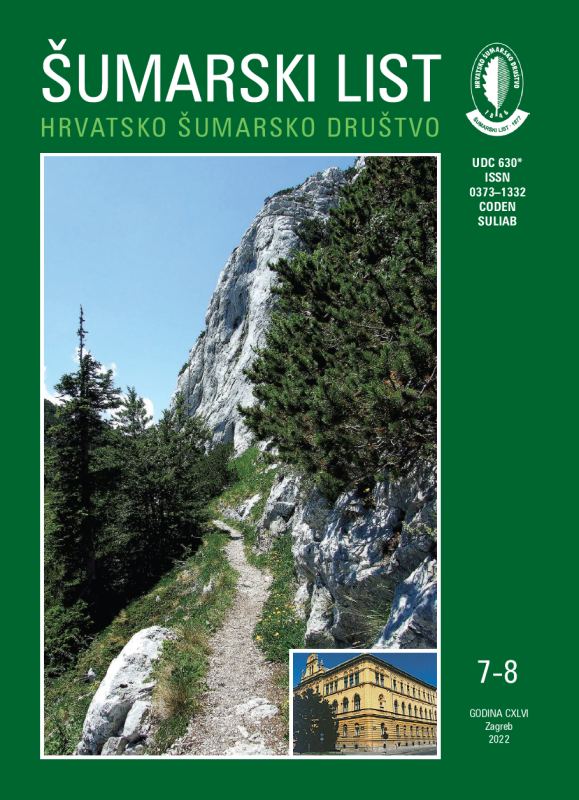
broj: 7-8/2022
pdf (12,97 MB) |
|
||||||||||||||
| RIJEČ UREDNIŠTVA | ||
| Uredništvo | ||
| Why do we lag behind in the green transition and energy independence? pdf HR EN | 281 | |
| IZVORNI ZNANSTVENI ČLANCI | ||
| Damir Ugarković, Ivica Tikvić, Ivana Grgurić, Ivan Perković, Nataša Hulak, Vibor Roje, Petar Šutalo, Krešimir Popić | UDK 630* 114.7 (001) https://doi.org/10.31298/sl.146.7-8.1 | |
| Enzymatic activity of forest soil in damaged forest ecosystem of silver fir with hard fern pdf HR EN | 283 | |
| Abstract With the decline of trees, habitat conditions change, resulting in changes in the microclimate and microbiological activity of the soil. The aim of the research is to determine the differences in the microclimate of habitats and in the enzymatic activity of forest soil in three forest gaps and three forest stands of silver fir with hard fern (Blechno-Abietetum Ht. 1950). Of the microclimatic elements, air temperature, soil temperature, relative air humidity and volumetric soil moisture were measured. Composite soil samples from a depth of 0 to 10 cm were collected to determine the chemical properties of the soil and the dehydrogenase and proteolytic activity of the soil. Significantly higher values of air and soil temperatures and significantly lower values of relative air humidity and volumetric soil moisture were found in forest gaps. The research did not reveal any differences in the chemical properties of the soil between forest gaps and stands. Due to insignificant changes in soil chemical characteristics, no significant changes in soil enzymatic activity were found in the gaps in relation to forest stands. Air temperature and soil temperature are related to soil dehydrogenase activity, while volumetric soil moisture is associated with proteolytic soil activity in forest gaps. Soil chemical characteristics also had a significant effect on enzymatic activity. By increasing the share of organic matter, nitrogen, humus and carbon in the soil, the enzymatic activity of forest soils also increases. The highest correlations between enzymatic activity and soil chemical characteristics were found for proteolytic activity of forest soils. The enzymatic activity of forest soils was highest at the beginning of the vegetation period under conditions of optimal soil temperature and soil moisture. Key words: forest gap; soil enzymes; soil chemical properties; silver fir | ||
| Krunoslav Sever, Antonia Vukmirović, Luka Hodak, Saša Bogdan, Ida Katičić Bogdan, Daniel Krstonošić, Tomislav Karažija, Jozo Franjić, Željko Škvorc | UDK 630*231 + 233 (001) https://doi.org/10.31298/sl.146.7-8.2 | |
| Functional adaptation of natural sessile oak and common beech saplings on different habitat conditions pdf HR EN | 293 | |
| Vladan Popović, Darka Šešlija Jovanović, Aleksandar Lučić, Ljubinko Rakonjac, Sanja Jovanović, Aleksandar Vasiljević, Danijela Miljković | UDK 630* 164 (001) https://doi.org/10.31298/sl.146.7-8.3 | |
| Spatial variation of morphological needle traits of silver fir (Abies alba Mill.) populations in the Balkan peninsula in relation to climatic factors pdf HR EN | 309 | |
| Vojislav Dukić, Miroslav Mirković, Branko Stajić, Danijela Petrović, Marko Kazimirović, Srđan Bilić | UDK 630* 111.8 (001) https://doi.org/10.31298/sl.146.7-8.4 | |
| Comparative analysis of the influence of climate factors on the radial growth of autochthonous pine species (Pinus spp.) in central Bosnia and Herzegovina pdf HR EN | 319 | |
| Abdullah E. Akay, H. Hulusi Acar, Buse Kalkan | UDK 630*907.1 (001) https://doi.org/10.31298/sl.146.7-8.5 | |
| Using GIS techniques for modeling of anthropogenic noise propagation generated by a chainsaw in forest harvesting pdf HR EN | 333 | |
| Alptug Sari | UDK 630*156 (001) https://doi.org/10.31298/sl.146.7-8.6 | |
| Maximum Entropy Niche-Based Predicting of Potential Habitat for the Anatolian Leopard (Panthera pardus tulliana Valenciennes, 1856) in Türkiye pdf HR EN | 345 | |


